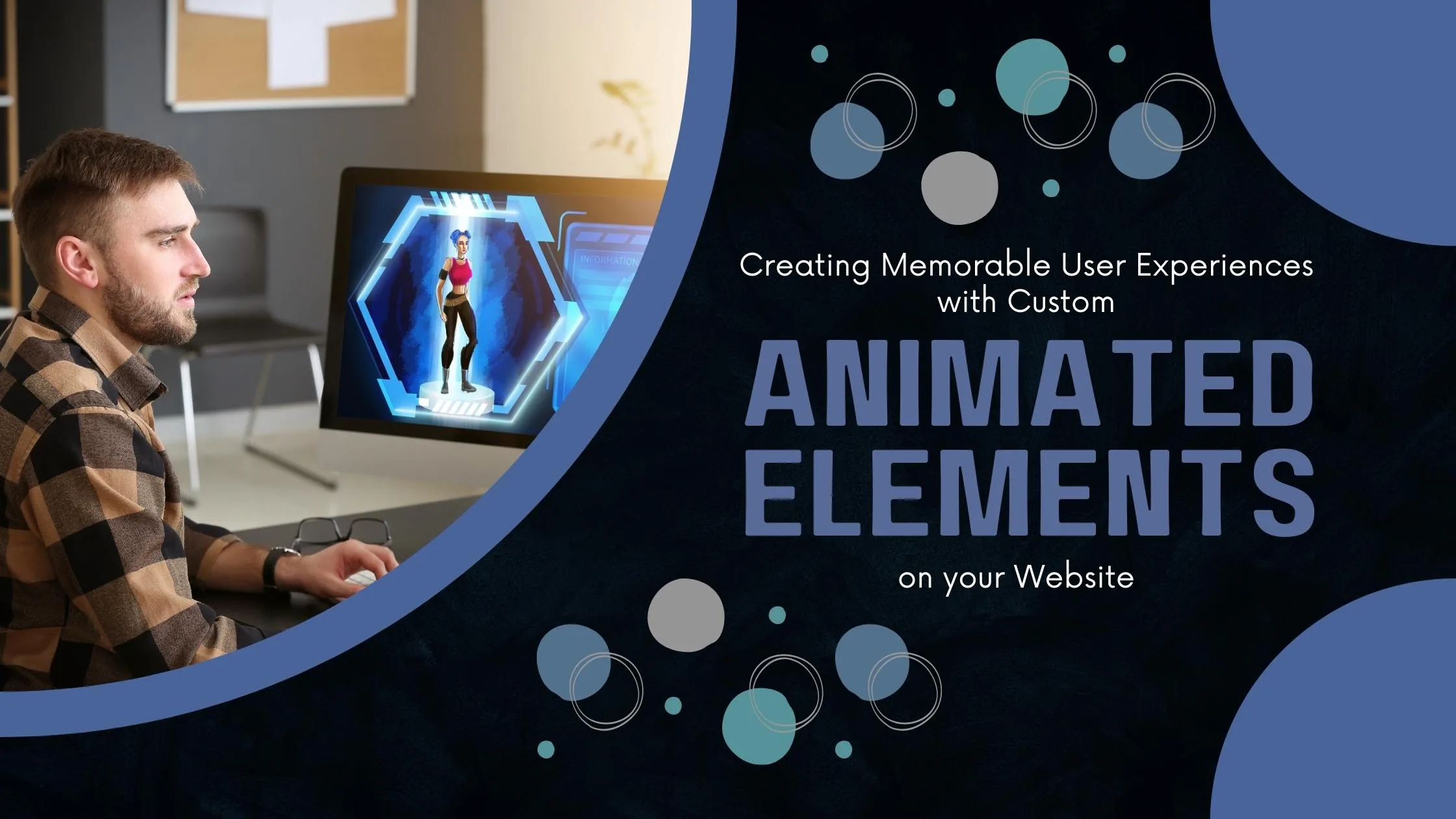Creating Memorable User Experiences with Custom Animated Elements on Your Website
In today’s fast-paced digital world, where attention spans are shorter than ever, capturing and maintaining user engagement on websites has become a significant challenge. As a web developer or designer, it’s essential to employ innovative techniques that not only make your websites visually appealing but also interactive and engaging. One such powerful tool in your arsenal is animation. When used effectively, animation can breathe life into your web experiences, making them more memorable, interactive, and enjoyable for users. Animations not only add personality and character to your website but also create memorable user experiences.
In this blog post, we’ll explore the benefits of using custom animations, provide tips for incorporating them into your design, and showcase some stunning examples from around the web.
Introduction to Animation in Web Design
Animation can be a powerful tool for creating memorable user experiences on your website. By adding custom animated elements, you can guide users through your site, highlight important information, and create a more engaging experience overall.
When used sparingly and in moderation, animation can be an effective way to improve the user experience on your website.
Here are a few tips for using animation in your web design:
1. Use animation to guide users through your site.
2. Highlight important information with animated elements.
3. Keep animations short and sweet to avoid overwhelming users.
4. Consider the overall tone of your website when selecting animations.
5. Test your animations before launching your site to ensure they work as intended.
Benefits of Incorporating Animation into Your Website
Animation is a powerful tool that can help you create memorable user experiences on your website. By incorporating animation into your website design, you can add an extra layer of interactivity and engagement that will delight your visitors and keep them coming back for more.
Here are just a few of the benefits of incorporating animation into your website:
1. Interactive and Dynamic Navigation:
Navigation is a crucial aspect of any website, and adding animation to your navigation elements can make it more intuitive and engaging. Consider implementing animated navigation menus, such as hamburger menus that transform into full-screen overlays or slide-in sidebars. Smooth transitions and subtle animations can make the navigation experience more enjoyable and help users find their way around your website effortlessly.
2. Enhance User Experience with Micro interactions:
Micro interactions refer to small, subtle animations that provide feedback, guide users, or add delightful moments throughout their interactions with a website. They can be as simple as a button changing color when hovered over or more complex, like a loading spinner during data processing. Micro interactions enhance the overall user experience by adding a layer of interactivity and responsiveness, making users feel more connected and engaged with the website.
3. Improved Engagement & Retention:
Users are more likely to stick around on a website that is visually interesting and engaging. Animation can help capture attention and keep users engaged with your content, leading to improved conversions and higher retention rates.
4. Greater Flexibility & Control:
With animation, you have greater control over how users experience your content. You can use animation to control the pace at which users view your content, or create custom animated elements that bring your brand to life in a unique way.
5 . Engage Users with Interactive Infographics:
Infographics are powerful tools for visual storytelling and conveying complex information in a concise and engaging manner. Adding animation to infographics takes them to the next level by allowing users to interact and explore the data dynamically. Consider animating data points, charts, and graphs to create interactive infographics that encourage users to interact, providing them with a deeper understanding of the information presented.
Tips for Crafting Engaging and Memorable User Experiences with Animations
1. Start by thinking about what kind of experience you want to create for your users. What feeling do you want them to have when they interact with your site?
2. Once you know the feeling you want to evoke, consider what kind of animations will best support that goal.
3. Keep your animations simple and concise. Too much movement can be overwhelming and distracting.
4. Make sure your animations are fluid and natural looking. Rough, jerky movements will break the immersion and disrupt the user experience.
5. Pay attention to timing and pacing. Animations should flow smoothly and at a pace that is comfortable for users.
6. Use animations sparingly and only when they genuinely improve the user experience. Overusing animations can make a site feel cluttered and busy.
Different Types of Animations to Consider User Experiences
If you’re looking to add some animated elements to your website in order to create a more memorable user experience, there are a few different types of animations you can consider.
Here are a few examples:
1. Animated illustrations or graphics: These can help add some personality to your website and make it more visually interesting for users.
2. Interactive animations: These can help make your website more interactive and engaging for users. For example, you could use an animation to reveal additional information when a user hovers over a certain element on your page.
3. Motion graphics: These can be used to add some visual interest to your site and help guide users’ attention to important information.
4. Loading animations: These can help reduce perceived wait times for users while content is loading on your page.
5. Scroll-triggered animations: These can be used to add some excitement or interest as users scroll down your page. For example, you could use a scroll-triggered animation to reveal additional content as users scroll down, or create an animated element that follows the user as they scroll.
How to Get Started with Adding Animations to Your Website
Animations can add a lot of personality and life to your website. They can help tell your brand story, add visual interest, and make your site more memorable. But how do you get started with adding animations to your website?
Here are a few tips:
1. Know what you want to achieve with your animation. Whether it’s to tell a story, engage your users, or just add some visual interest, having a clear goal in mind will help you create a better animation.
2. Keep it simple. Don’t try to do too much with your animation. A few seconds of movement is usually all you need to make an impact.
3. Make sure your animation is compatible with all browsers and devices. Not all browsers and devices support the same web standards, so you’ll need to do some testing to make sure your animation looks great on all of them.
4. Pay attention to performance. Animations can impact the performance of your website, so be sure to test things out and make sure everything is running smoothly before you launch it live.
5. Use tools like GreenSock or Snap SVG for complex animations. If you’re looking to create more complex animations, there are some great tools out there that can help you achieve professional results without having to be a professional animator yourself.
Examples of Inspirational Websites that Utilize Animation Effectively
The internet is full of amazing websites that utilize animation effectively to create memorable user experiences.
Here are just a few examples:
1. AirBnB – AirBnB uses subtle animations throughout their website to guide users through their booking process. These animations help simplify a complex task and make it feel more fun and approachable.
2. Google Maps – Google Maps uses animation to provide users with an interactive experience when exploring different locations. By animating the map as you scroll, pan, or zoom, users can get a better sense of the lay of the land and find their way around more easily.
3. Slack – Slack uses animation to bring some personality to their messaging app. The little animations when you open or close a direct message, for example, help make the app feel more friendly and human.
4. Stripe – Stripe uses simple animations throughout their website to help explain complex concepts in a visually-appealing way. For example, their animated FAQ section breaks down key topics into bite-sized chunks that are easy to understand.
5. Trello – Trello employs engaging card-based animations throughout their project management tool to make it feel more dynamic and alive. These animations help users navigate between boards and cards, and also give feedback when actions are taken (like moving a card from one board to another).
Conclusion
We hope this article has helped you gain a better understanding of how to create memorable user experiences on your website with custom animated elements. By leveraging the power of animation, you can make your website stand out from the competition and engage users in new and innovative ways.
Animated elements are an easy way to bring life to your website while providing valuable visual cues that help guide users along their journey. With these tips, you’ll be able to take advantage of all the benefits animation offers and create a positive user experience for everyone who visits your site.





